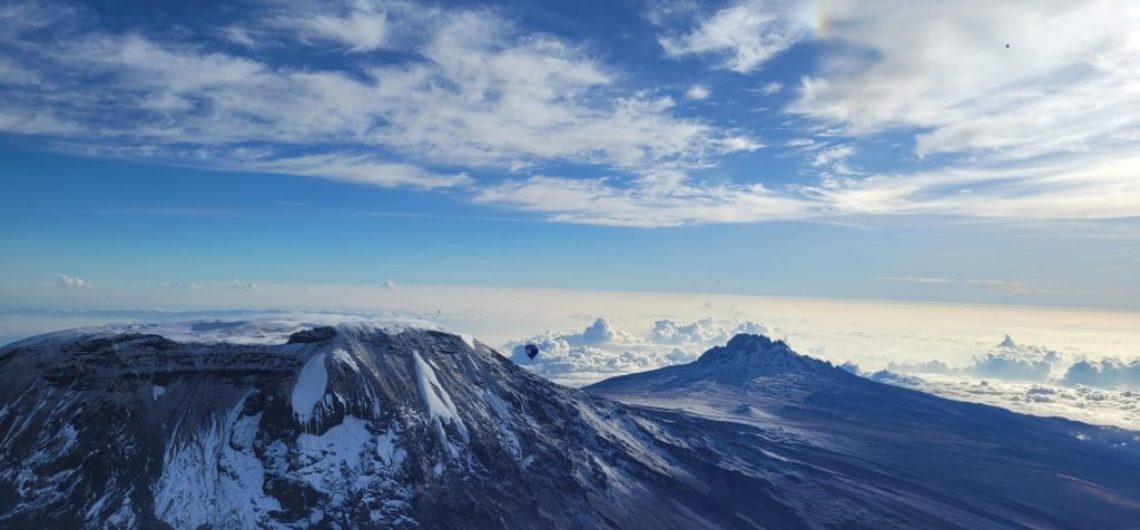Well, who has never heard of it? Mt. Kilimanjaro, the icon, the name so engraved in most of us, well, I presume most of us. It would be safe to say that but then again this series of articles would stop here. This African icon nicknamed the ‘roof of Africa has intrigued the local population as well as early European explorers. In 1885 Jim Thompson made an unsupported claim that Kilimanjaro, to the locals meant Mountain (Kilima) of Greatness (Njaro). This is understandable considering the tribes living around the mountain and their reverence to the mountain in relation to their beliefs and day to day life.
The Roof of Africa looks imposing and beautiful all at the same time even from afar.
Our towering mountain is located in East Africa, in the beautiful country of Tanzania. Mount Kilimanjaro is located near the border of Tanzania and Kenya, just 3 degrees south of the equator, and yes, it will be a surprise on you upon seeing snow on the inviting mountain summit. So towering is the mountain that its visible from the towns of Moshi, Arusha, in Tanzania and also from the Tsavo and Amboseli parks not very far away in neighbouring Kenya.
The exact mountain specifications are 24 miles wide, and 49 miles long. And the mountain boasts of 3 craters that add to the air of mystery that Kilimanjaro has. The volcanic craters are Kibo, Shira and Mawenzi. The smallest but the oldest of the peaks is Shira standing at 3962 m. Fortunately or unfortunately, depending on your stand on mother nature, the volcanic centre became extinct.
Kibo is categorized as dormant and not extinct and it’s the highest of the three peaks. Standing at 5895 m high and at 1.5 miles wide. Mount Kilimanjaro’s Uhuru peak is officially the highest point in the continent and most mountaineers’ fantasize on how to summit it. I bet it’s also a major part of their new year resolutions!
A mountaineers dream is to summit to Uhuru Peak, the highest point on the mountain.
The history behind this mountain is indeed great. A legend of the Wachagga tribe tells of Mawenzi borrowing fire for its smoking pipe from his younger brother Kibo. The Wachagga people reside on the fertile volcanic soils around the base of the mountain. They have been living in the area for around 300 years ago therefore, this legend suggests very recent volcanic incident. Chinese and Arab historians’ accounts speak of an enormous mountain lying inland from Zanzibar or Mombasa and its a fact that very few early traders ventured into the interior of the continent.
Slave traders passed below it and sometimes raided the villages of the Wachagga but it was not till the middle of the 19th century that a more serious interest was taken in the mountain and attempts were made to scale it. In 1848, a German missionary, Johann Rebmann, spotted the mountain while traversing the Tsavo plains.
An account by his guide informs that the mountain was very cold and attempts to send porters to the summit to secure minerals resulted in their return with water only. As usual at this time, Rebmann’s accounts generated enormous interest back at home and numerous expeditions were organised in later years. Dr. Hans Meyer would be the first to summit the highest point on October 5th 1889, having only reached Kibo in 1887, during his first ascent attempt that backfired due to his lack of requisite gear to overcome the ice and deep snow on Kibo.
Many thousands of walkers are now attracted to the highest mountain in Africa each year. A spectacular moment in the history of the mountain is when over 1000 people ascended the summit to see the sunrise over a new century and Millennium on January the 1st 2000. Your experience here in one of the richest world heritage sites that has wowed man since 1000BC is bound to be unforgettable and inspiring moments of your life.
On top of Africa: dreams do come true and yours will too.
An anonymous AD45 travel guide named Periplus of the Erythreaan Sea, accounted for India, Arabia and Africa sea routes. In it the author mentions a country named Azania and an inland mountain that was instrumental in that it was a major navigational aid for traders travelling between the East African coast and the interior.
So fascinating is the mountain that a Hollywood Romance film named The Snows of Kilimanjaro was shot in 1952. The drama film full of adventure in this still enchanting land reflects writer Harry Street on his life as he lies dying from an infection while on safari in the shadow of Mount Kilimanjaro.
Your mountain climb experience is guaranteed to be one of the best and challenging though never regrettable decisions you will make in your life. Now that you know all about the mountain, check the next article on Preparing for your Climb.
![]()


Comments